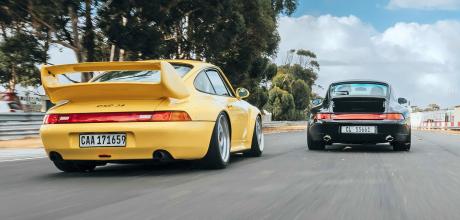1993 Porsche 911 Carrera 993 vs. 1998 Porsche 911 Carrera RSR 993
They represent opposite ends of the naturally aspirated 993 range. Total 911 drives the base Carrera and rare RSR back-to-back on track.
CARRERA VS RSR
Written by Wilhelm Lutjeharms
Photography by Peet Mocke
30 YEARS OF 993 — ROAD VS RACE
CHARTING THE EVOLUTION OF PORSCHE’S LAST AIR-COOLED 911
GENERATION AS STREET CARRERA TAKES ON THE MIGHTY RSR
993 Carrera v RSR We kick-off our 30 years of 993 celebrations with a drive of the street Carrera and circuit-bred Carrera RSR…
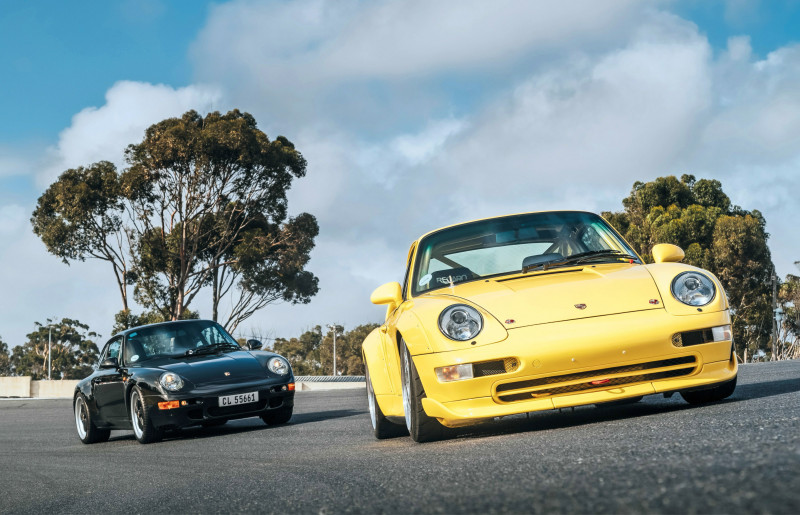
It’s always an unforgettable experience, driving the Alpha and Omega of a specific car range. Be it the Cayenne e-Hybrid and the Cayenne Turbo GT, or from the current 911 range in the form of a standard Carrera and GT3 RS.
Back in the ’90s, Porsche’s 911 range was simpler. Apart from the Carrera, the 993 range offered the S models, Turbo (and Turbo S), as well as the much-loved and highly respected GT2.

Rarely do we see one of the most sought-after 993 models in public, though: the very special 993 Carrera RSR. It is, after all, a race car, so you’re unlikely to see one on the road at all. However, when you consider what this car represents, it stands head and shoulders above all its other 993 siblings. Even better is that this specific RSR is registered on the road, and the owner sometimes stretches its legs on mountain passes in the area.
On the other side of the naturally aspirated spectrum is the 993 Carrera. It’s arguably the purest model in the range because it’s the genesis of what is, for many enthusiasts, the pinnacle of air-cooled Porsche. As we celebrate 30 years of the 993 in 2023, this very car was – rather appropriately – built in 1993 and is one of the first 1,500 manufactured.
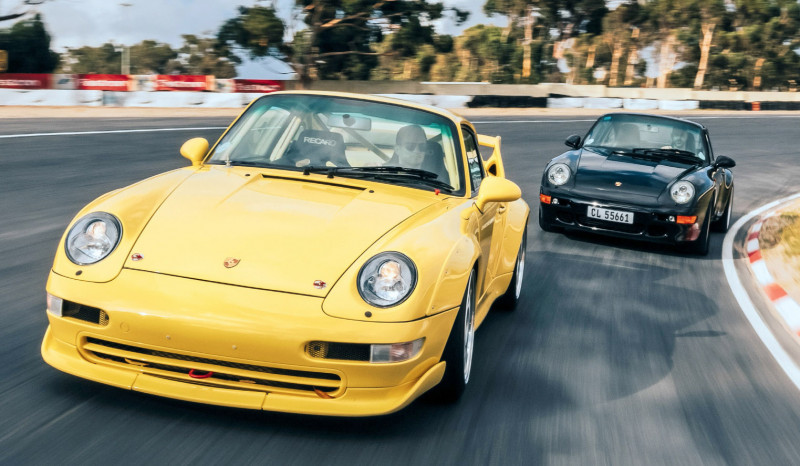
“The first owner was a doctor in Hamburg who imported the car to South Africa in 2008,” explains the current owner. “I traded my SC for this car in 2016. I believe it’s the best balance between a classic and modern car. You have good air-conditioning and enough power. The first owner also picked the right options on this car. I bought it with 68,000 miles on the odometer, and I’ve since added 7,900 miles.” Both owners haven’t spared any expense on either of these cars’ maintenance.
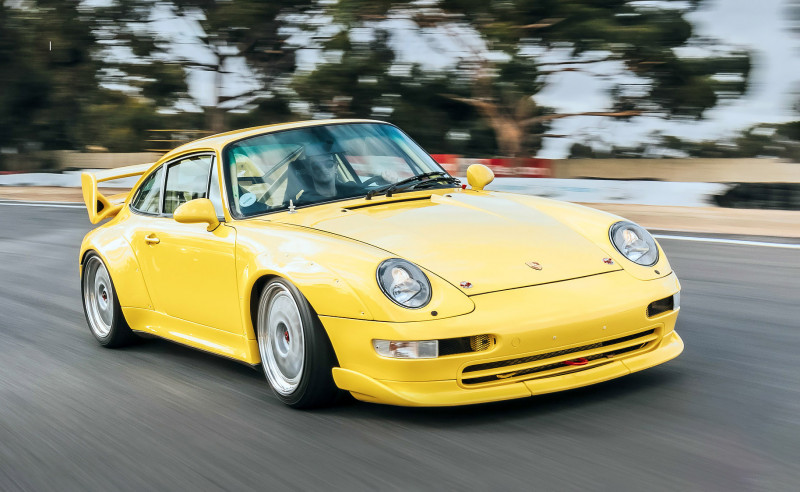
There are two welcoming and appropriate updates the Carrera owner did to the car. The first was fitting a set of stunning two-tone modern Fuchs wheels (now fitted with 265/35 ZR18 tyres at the rear and 225/40 ZR18 at the front) and installing the front bumper from the Carrera S. Looking at the car in profile, it looks purposely squatted, with those beautiful 993 curves covering the wheels while also being compact when compared to modern 911s.
As the Carrera RSR pulls into the pit lane, the contrast of how a car can be transformed into a racer immediately dawns. Make no mistake, the curves are still there and it’s immediately recognisable as a 993, but the racing intent of the car shouts from every single angle. At the front, the small side-winglets remind you of the Carrera RS, while the flared wheel arches at the rear are similar to the GT2 (although the dimensions are different). Of course, the rear wing is unmistakably pure race car, while being still relatively smooth and reined in compared to modern RSR examples.
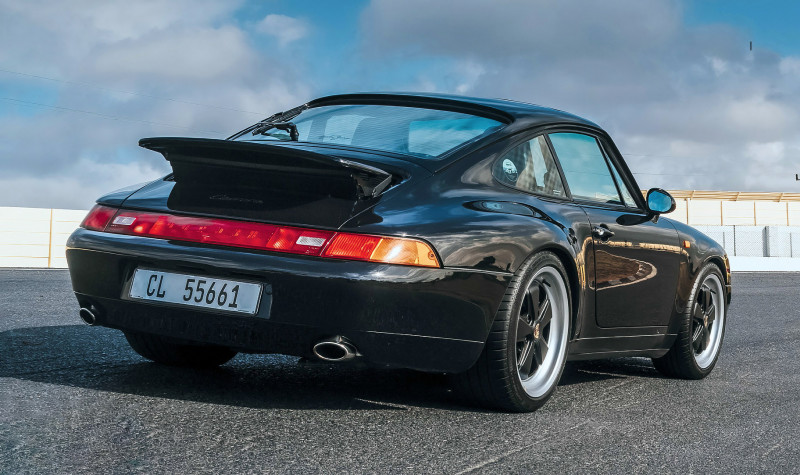
You hear, rather than see this car coming, even from a mile away. Even at idle there’s a deep, loud and throaty exhaust note.
However, let’s start on the correct side of history, and as I open the door of the Carrera and climb inside, I’m impressed by the condition of the cabin. It’s hard to tell that I’m sat in a 30-year old car. It feels and looks solid, while the seats are comfortable and the driving position is good – even though the steering wheel is close to the dashboard and not adjustable. I’m again reminded how compact these earlier 911s are; you feel more a part of the car compared to modern versions.
As I pull on to the Killarney International Raceway outside Cape Town, the gearshift feels slick and direct while the engine offers decent amounts of torque. Even as low as between 2,000 and 3,000rpm in a high gear, you can expect the tractable engine to accelerate the car purposefully down the road. The street Carrera’s suspension, even with this factory sports setup, does a sterling job. It feels planted on the asphalt, but still offers an admirable level of absorption that leads to a comfortable ride.
With all the fluids warmed up I let the rev needle run a bit higher. Mid-range punch is perfect, but push the engine run past 4,000rpm and it comes alive – and then there’s still several hundred revs left after 6,000rpm, where I change up.
With a large part of the nose of the car in perfect view, I know exactly where the front extremities of the 993 are, and threading it through corners is a cinch. I also realise that where your feet are is close to the front wheels, also assisting in placing the car. There’s a beautiful, hollow, metallic sound from the exhaust – not too loud – that elevates that flat six sound for your enjoyment too. The brakes feel strong and even under hard braking there’s little in terms of nose dipping from the suspension. The steering wheel, meanwhile, gives honest feedback and all too soon I have to pull into the pits and park behind this 993’s fire-breathing circuit sibling.
I open the lightweight door (which feels like you’ll be able to pick it up with a couple of fingers) and observe the painted-metal race car cabin. The roll cage and Recaro race seats are strong reminders this car is intended to line up in front of the lights at the race track, chasing that chequered flag. For now, the owner has stored the SCHROTH six-point harness, making it almost easy in terms of ingress and egress – except for the roll-cage.
Imported to South Africa shortly after it was produced, the car was sold to its second owner before the third owner bought it in 1999. He kept it for no less than 20 years before he sold it back to the second owner.
During his 20-year ownership the car was used only on special occasions, resulting in an odo reading of only 5,600 miles. This included a lot of mileage on the road and one six-hour endurance race at Phakisa Freeway in Welkom, South Africa. The result is that the car is in perfect condition, having never been involved in an accident on the track. It still has its original trim, and matching engine and gearbox. Today the car has covered only a few hundred kilometres since the second owner bought it back.
I strap myself in and slam the door shut. The hollow clang of the door closing firmly reverberates through the cabin; the stripped-out interior, with its exposed metal, is as raw as you’d expect. Now I feel completely part of the car – a special sensation. The size of these older Porsche 911s is something to appreciate. They’re compact while my view (even when seated this low) is perfect over the short front bonnet. I can’t help but revel at the sight of the large rear arches in my side mirrors as well as that prominent wing in my rear-view mirror. The driving position is as close to perfect as I’d imagined, with the Alcantara-covered steering wheel close to my chest and the naked gearlever close to my right hand – oh, how I love a proper race car!
Twist the key and a loud rumbling from the drivetrain immediately fills the cabin. Press the clutch and the clattering quietens down, but let the clutch out and the sounds from the input shaft and gears make themselves blatantly heard. There’s a mechanical element that you experience in a race car which no road car can offer or replicate.
The clutch bites stronger and quicker than any 993 road car I’ve driven, but that’s to be expected. With no pressure from fellow racers, timing equipment or any other race-related authority, I can effortlessly absorb the experience and process every little nuance the car feeds me through all my senses.
The moment I pull away, I realise how stiffly sprung the suspension is and how the car moves as an entity. On the track the immediacy of the steering wheel when I turn it only marginally is such a highlight that I wish all modern sports cars offered – such a direct steering ratio. The entire car brims with feedback. At the same time I can sense how it’s tricky for the car to move in a straight line. Owing to the camber configuration of the front wheels, it’s set up to dive into a corner the moment you move the steering wheel off dead-centre.
The sound in the cabin is deafening, yet I can’t help but enjoy every moment I flex my right foot. The metallic flat six sound increases in its intensity as I watch the revs climb past 5,000rpm and I wonder what the car must sound like as I pass the pits – surely looking and sounding like nothing else this track has seen in a while.
My trust in the mechanical grip of the car grows with every second behind the wheel. As the RSR gathers momentum, that raw, metallic intensity of the engine makes itself heard as I pass 4-, 5- and 6,000rpm. The nose sniffs out any changes in and on the track surface – it’s extremely sensitive. The gearlever slips easily between the ratios and the immediacy of the throttle is something to savour as the M65/75 race engine reacts.
It’s such a raw and concentrated driving experience that you can’t help but admire, first, why enthusiasts adore the air-cooled RSR; and second, why enthusiasts enjoy racing them. Together with the 993 GT2 race cars, these cars were the pinnacle of air-cooled and if you prefer your car to be naturally aspirated, this is the ultimate version ever to leave the factory. It seems this is also the only RSR to leave the factory in Pastel yellow.
As the new owner told me, buying this car again after 20 years: “Sometimes you part with something in your life that you know will come back to you. That has always been my feeling about the car. I regretted selling it, but I’m more delighted to get it back”.
As a balanced daily driver, the street Carrera has few peers, but for pure thrills, occasional track excursions and a never-ending sense of fun, the RSR could sit close to the top of the 911 pyramid. Both these cars represent important highwater marks in Porsche’s air-cooled history, although each will appeal to a very different enthusiast.
ThanksSpecial thanks to both owners and Crossley & Webb for making this article possible.
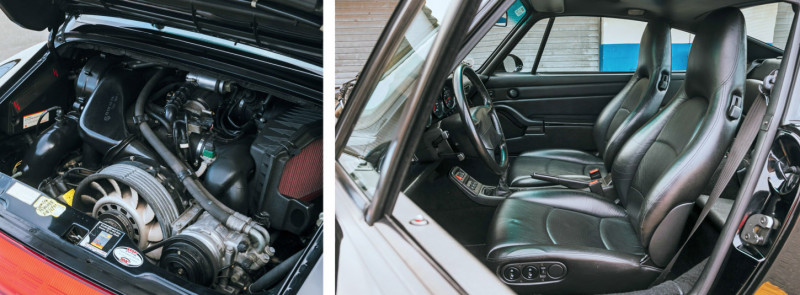
TOP It’s easy for the RSR to take all plaudits, but the real hero is the street Carrera: a car that provided a template for the RSR race car, and one that delivered both all-round performance and refinement for the celebrated 993 era
ABOVE It might lack the pace, downforce, soundtrack and sharpness of that RSR, but the 993 Carrera will still thrill on road and track.
LEFT With refinement comes weight, and so it’s not hard to see from its interior why the street Carrera weighs 200kgs more than the RSR.
RIGHT The early 993 Carrera’s flat six made do without VarioRam induction, which debuted on the RS in 1995 and used on the RSR to improve mid-range torque.
“The 993’s suspension, even with this factory sports setup, does a sterling job”
TECHNICAL DATA
- Model Porsche 911 Carrera 993
- Year 1993
Engine
- Capacity 3,600cc
- Compression ratio 11.3:1
- Maximum power 272bhp at 6,100rpm
- Maximum torque 330Nm at 5,000rpm
- Transmission Six-speed manual
Suspension
- Front Independent, McPherson struts, anti-roll bar
- Rear Independent, double wishbones, coil springs, anti-roll bar
Wheels & tyres
- Front 7x16-inch; 205/55 ZR16
- Rear 9x16-inch; 245/45 ZR16
Dimensions
- Length 4,245mm
- Width 1,735mm
- Weight 1,370kg
Performance
- Acceleration 0-62mph 5.3 seconds
- Top speed 166mph
“It is such a raw and concentrated driving experience…”
ABOVE RSRs came with GT2-style, tacked-on arches. Supercup cars retained the arch profile of the road-based Carrera RS.
LEFT The 993 RSR’s naturally aspirated flat six produced between 325-340bhp depending on competition regulations.
RIGHT 30 years of racing the 911 lead to this: the pared-back, high-revving Carrera RSR of 1997.
TECHNICAL DATA
- Model Porsche 911 Carrera RSR 993
- Year 1998
Engine
- Capacity 3,746cc
- Compression ratio 11.4:1
- Maximum power 325bhp at 6,900rpm
- Maximum torque 353Nm at 5,500rpm
- Transmission Six-speed manual
Suspension
- Front MacPherson struts, coil springs, adjustable gas dampers, anti-roll bar
- Rear Multi-link, coil springs, gas dampers, anti-roll bar
Wheels & tyres
- Front split-rim, 250/640 R18 slicks
- Rear split-rim, 280/640 R18 slicks
Dimensions
- Length 4,245mm
- Width 1,735mm
- Weight 1,120kg (dry)
Performance
- Acceleration 0-62mph 4.0 seconds
- Top speed 162mph

LEFT The same, yet completely different: the road-based 993 Carrera is drowned out by the raucous 993 Carrera RSR racer.
BELOW Tony Hatter’s timeless design of the 993 was extensively reworked for the RSR’s specific purpose of racing in championships around the globe


